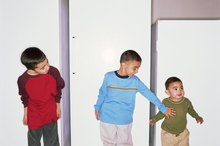Tangible and Intangible Rewards for Good Behavior in Children
Children often need external incentives to give them the necessary motivation to succeed. As you strive to help your child adopt good behavior habits, consider using both tangible and intangible rewards. Although different, both types of rewards can help give children a firm push in the right direction.
Wisdom of Rewards
Children often learn faster and more easily when parents offer rewards for good behaviors, according to the article ''Psychological Development in Early Childhood'' from California State University, San Marcos. Although rewarding good behavior may seem akin to bribery, Australian psychologist John Waring's article "Rewards and Recognition" assures parents that using rewards to motivate good behavior in children is significantly different from bribing someone to commit a crime or other type of negative behavior 23. Instituting a reward system can also be an effective way to begin focusing on positive behaviors instead of giving time and energy to undesired behaviors.
External Vs. Internal Rewards
The Operant Conditioning Principles Used to Teach Someone to Ride a Bike
Learn More
As parents consider rewards, there are two different types of rewards to use to motivate behavior, according to California State University, San Marcos. External rewards are rewards that a child might receive, originating separately from child. External rewards include both tangible and intangible rewards. Internal rewards originate inside the child, and include powerful feelings such as a sense of accomplishment or personal pride in an achievement.
- As parents consider rewards, there are two different types of rewards to use to motivate behavior, according to California State University, San Marcos.
- Internal rewards originate inside the child, and include powerful feelings such as a sense of accomplishment or personal pride in an achievement.
Tangible Rewards
Tangible rewards are the items you can hold, see or touch. Examples of tangible rewards include toys, candy, stickers, a ride on an amusement park ride or a trip to the movies. Children often respond positively when you offer tangible rewards for good behavior because it helps them focus their effort and energy to receive the reward. To help your child maintain momentum and progress, provide the tangible rewards daily for preschoolers or toddlers and at least weekly for older children.
- Tangible rewards are the items you can hold, see or touch.
- Examples of tangible rewards include toys, candy, stickers, a ride on an amusement park ride or a trip to the movies.
Intangible Rewards
OT Exercises for Seniors
Learn More
In conjunction with tangible rewards, provide continual intangible rewards to help your child stay motivated and energized. Examples of intangible rewards include:
- verbal praise
- smiles
- pats on the back
- hugs
- extra attention
- special privileges
An effective system for encouraging children might incorporate special tangible rewards the child earns at specific times, with intangible rewards added continually to keep the child motivated and energized.
Related Articles
References
- Academia: Improving Child Behavior Management: An Evaluation of the Good Behavior Game in UK Schools
- John Waring and Associates: Rewards and Recognition
- John Waring and Associates: Rewarding Good Behavior
- George J. DuPaul and Gary Stoner, ADHD in the Schools: Assessment and Intervention Strategies. The Guilford Press. 2004.
- William Pelham. How to Establish a School-Home Daily Report Card. Center for Children and Families, University of Buffalo, State University of New York.
Writer Bio
Kathryn Hatter is a veteran home-school educator, as well as an accomplished gardener, quilter, crocheter, cook, decorator and digital graphics creator. As a regular contributor to Natural News, many of Hatter's Internet publications focus on natural health and parenting. Hatter has also had publication on home improvement websites such as Redbeacon.









